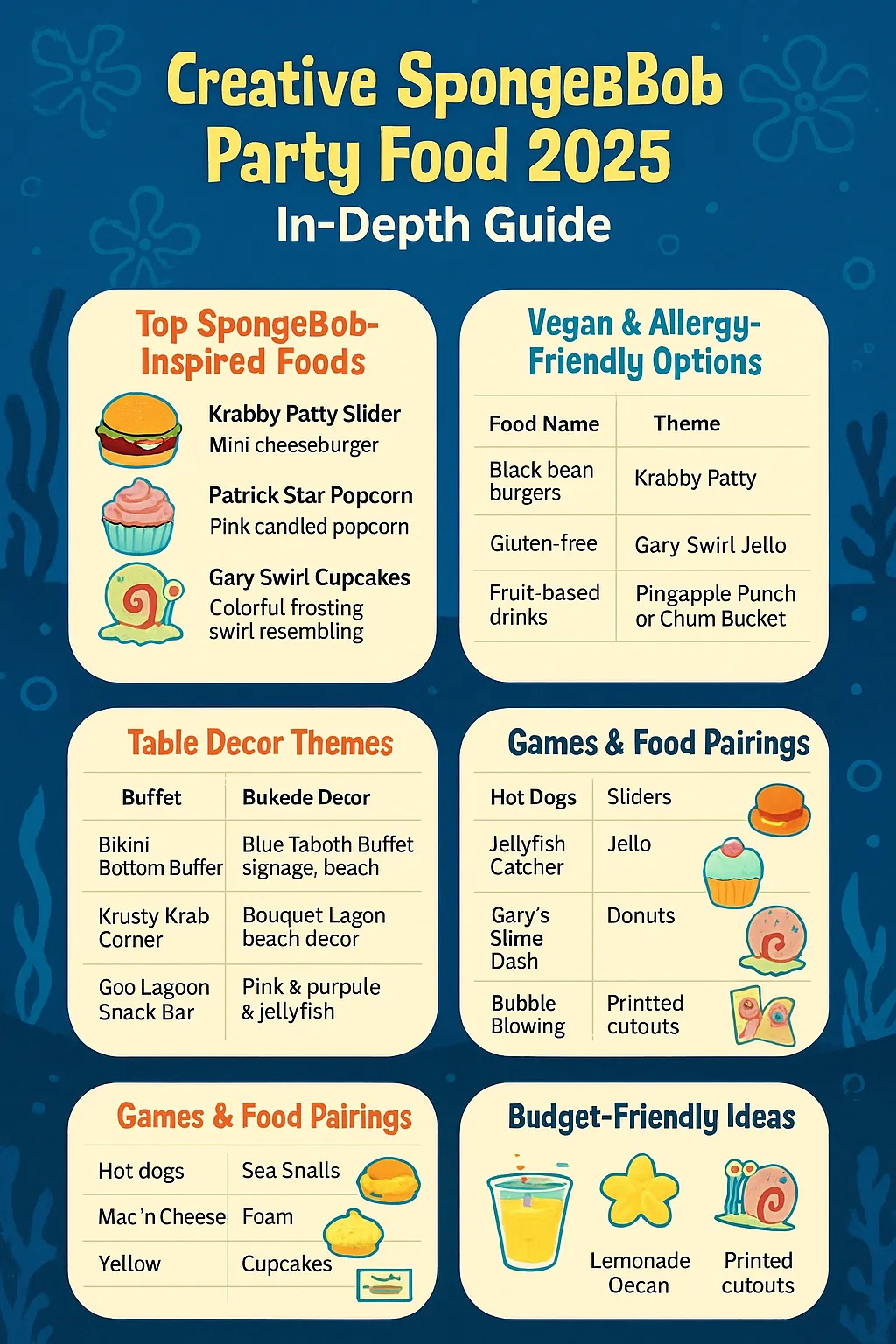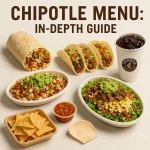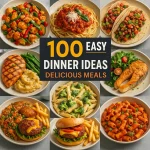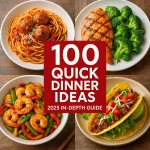
Table of Contents
🧽🎉 Creative Spongebob Party Food 2025 In-Depth Guide
The Ultimate Guide to SpongeBob-Themed Party Food Ideas, Recipes, and Presentation Tips for Kids & Adults Alike!
🎈 Part 1: Why SpongeBob Party Themes Rule in 2025
SpongeBob SquarePants has been a pop culture icon for over two decades, and in 2025, he’s bigger than ever! 🧽✨ With new spin-offs, merchandise, and meme culture keeping the fandom fresh, SpongeBob-themed parties are a hit with both kids and nostalgic adults.
Whether you’re planning a birthday bash, baby shower, or summer BBQ, turning your food into Bikini Bottom masterpieces is the perfect way to wow guests.
📊 Trending Data (Why SpongeBob Is Still Hot in 2025)
| Trend Indicator | 2025 Stat 🔍 |
|---|---|
| Google Trends Interest | 📈 Steady 8% rise YOY in “SpongeBob party food” searches |
| TikTok Hashtag Views | 🎥 #spongebobpartyfood – Over 23M views as of May 2025 |
| Pinterest Pin Growth | 📌 +19% engagement on SpongeBob DIY food boards |
| YouTube Party Tutorials | 📺 Top videos average 300K+ views per SpongeBob cake idea |
🧠 Insight: Parents and Gen Z adults planning nostalgic parties are the top demographics. SpongeBob resonates across generations — the perfect party theme!
🍔 Part 2: Signature SpongeBob-Inspired Dishes
Below is a list of the most iconic SpongeBob-themed food ideas you can recreate easily. Most items require simple ingredients and minimal prep. ✅
| Dish Name | Theme Element | Description 📝 | Difficulty | Ideal For |
|---|---|---|---|---|
| 🍔 Krabby Patties | Mr. Krabs’ signature burger | Mini sliders or cookie sandwiches with custom flags | Easy | Main Meal, Treats |
| 🍍 Pineapple Punch | SpongeBob’s home (pineapple) | Fruity tropical drink with pineapple chunks | Easy | Drinks |
| 🧁 Jellyfish Cupcakes | Jellyfish Fields | Cupcakes with pink “tentacle” frosting & candy eyes | Medium | Dessert |
| 🐚 Sandy’s Acorns | Sandy Cheeks from Texas | Chocolate-covered donut holes shaped like acorns | Easy | Snacks |
| 🐠 Chum Bucket Jello | Plankton’s failed restaurant | Colored gelatin in jars with gummy worms | Easy | Fun Novelty Treats |
| 🍕 Goo Lagoon Pizza | Goo Lagoon beach scenes | Personal pizzas with blue sauce and fish gummies | Medium | Lunch/Dinner |
| 🦑 Squidward Snacks | Artistic, moody vibes | Charcuterie board with olives, cheese, and crackers | Medium | Adults’ table |
🧽 Pro Tip: Use free SpongeBob food flag printables on toothpicks to instantly theme ordinary snacks!
📋 Part 3: Kid-Friendly SpongeBob Snack Platters
Perfect for busy parents or school parties, these snack platters are DIY and allergy-conscious. 🎨🍿
SpongeBob Bento Box Layouts
| Slot Type | Example Snack | SpongeBob Reference |
|---|---|---|
| Protein | Turkey rolls or plant nuggets | Krabby Patty |
| Fruit | Pineapple cubes & blueberries | SpongeBob’s house |
| Crunchy | Seaweed chips or goldfish crackers | Undersea snacks |
| Sweet Treat | Mini jellyfish gummies | Jellyfish Fields |
| Surprise Toy | SpongeBob stickers/toy ring | Party bonus! |
🎂 Bento-style trays keep kids engaged and give parents flexibility with food preferences.
🛒 Where to Buy Themed Food Supplies:
🎂 Part 4: SpongeBob Cakes, Cookies & Desserts 🍭
No party is complete without themed sweets — especially when SpongeBob’s universe is full of colorful and quirky ideas. These desserts aren’t just delicious; they’re visually stunning and Instagram-worthy! 📸🎉
🎂 Top 5 SpongeBob-Inspired Desserts
| Dessert Name | Visual Theme 🎨 | Description 📝 | Skill Level |
|---|---|---|---|
| SpongeBob Face Cake | His iconic square yellow face | Use a rectangular cake with fondant or buttercream for SpongeBob’s face | Intermediate |
| Jellyfish Jell-O Cups | Jellyfish Fields | Pink Jell-O with whip cream and candy tentacles | Easy |
| Patrick Star Cookies | Starfish shape, pink frosting | Sugar cookies shaped like Patrick and frosted in pink with goofy faces | Medium |
| Pineapple Upside Cake | SpongeBob’s house | Traditional upside-down cake with SpongeBob cupcake toppers | Easy |
| Gary Snail Donuts | Gary’s shell swirl | Donuts glazed in swirl patterns with candy eyes | Medium |
🧁 Pro Tip: Use piping gel and edible markers to create SpongeBob’s signature goofy smile!
🌱 Part 5: Vegan, Gluten-Free & Allergy-Friendly Options
In 2025, dietary inclusivity is a must — especially for kid-friendly events. The good news? You can still create fun, themed SpongeBob treats for everyone at the party!
🥗 SpongeBob-Inclusive Menu Swaps
| Food Type | Allergy-Friendly Swap 🥬 | SpongeBob Reference 💡 |
|---|---|---|
| Krabby Patty Sliders | Black bean or chickpea patties | Bikini Bottom burger joint |
| Jellyfish Cupcakes | Gluten-free cupcake mix | Still whimsical and vibrant |
| Pineapple Punch | Coconut water + fresh juice blend | Tropical, sugar-free version |
| Gary Donuts | Baked oat flour + fruit glaze | Soft, chewy, no allergens |
| Chum Bucket Jello | Agar-agar instead of gelatin | Vegan, and just as colorful! |
📚 Reference:
🧠 Bonus Tip: Use color-coded labels or icons on buffet cards (🌱 = vegan, 🌾 = gluten-free) to help guests choose confidently.
🎊 Part 6: Table Decor & Presentation Tips
Your party table isn’t just for serving food — it’s part of the under-the-sea experience! 🌊✨ Here’s how to decorate your food zone for maximum impact.
💡 Top SpongeBob Food Table Themes
| Theme Name | Key Decor Elements | Best For |
|---|---|---|
| Bikini Bottom Buffet | Blue tablecloths, seashell scatter, SpongeBob signage | Full kid party layout |
| Krusty Krab Corner | Menu-style signs, burger trays, Mr. Krabs cutouts | Slider station |
| Goo Lagoon Snack Bar | Sand-colored decor, beach toys, surfboards | Dessert or drink table |
| Jellyfish Fields | Floating jellyfish balloons, soft pink & purple | Candy table or cupcake station |
🎨 Creative Decor Tip:
Use fishnets over your table, mix in real or plastic shells, and DIY centerpieces using SpongeBob figurines inside glass jars.
📦 Where to Find Decor Supplies:
- Oriental Trading – Under the Sea Party Kits
- Walmart – SpongeBob Decorations 2025
- Michaels – Craft Supplies for DIY Decor
🥤 Part 7: SpongeBob Drink Station Ideas 🍹
No Bikini Bottom bash is complete without a splash-worthy drink station! Here are fun, themed beverage ideas that bring the ocean to your guests’ cups. 💦🐚
🧉 Top 5 SpongeBob-Inspired Drinks
| Drink Name | Ingredients 🧪 | Theme Inspiration 🌊 | Kid-Friendly? ✅ |
|---|---|---|---|
| Pineapple Power Punch | Pineapple juice, orange soda, lime slices | SpongeBob’s pineapple home | ✅ Yes |
| Bubble Blower Fizz | Lemon-lime soda + cotton candy topper | SpongeBob’s love of bubbles | ✅ Yes |
| Jellyfish Juice | Berry punch + pink lemonade + fruit bits | Jellyfish Fields | ✅ Yes |
| Goo Lagoon Lemonade | Blue raspberry syrup + lemonade | Goo Lagoon | ✅ Yes |
| Chum Bucket Brew | Root beer + whipped cream (for fun!) | Plankton’s infamous Chum Bucket | ✅ Yes |
🧊 Pro Tip: Add fun straws with character toppers (🧽 SpongeBob, 🐙 Squidward, 🐌 Gary) or print reusable name tags for each cup!
📚 Drink Station Resource:
🎯 Part 8: Games & Food Pairings 🍕🎮
Want to keep kids (and grown-ups!) entertained? Pair your themed snacks with interactive food games that tie into Bikini Bottom adventures.
🕹️ Game + Food Combo Ideas
| Game Name | Activity Description 📝 | Food Pairing Recommendation 🍿 |
|---|---|---|
| Krabby Patty Stack Off | Race to stack foam burgers | Serve real Krabby Patty sliders 🍔 |
| Jellyfish Catcher | Net toss game with balloon jellyfish | Jellyfish Jell-O cups 🍧 |
| Gary’s Slime Dash | Slime relay game for kids | Gary swirl donuts 🍩 |
| Bubble Blowing Contest | Who blows the biggest bubble? | Bubble Fizz drinks 🥤 |
| Pineapple Toss | Toss rings onto pineapple tops | Pineapple-shaped cookies 🍪 |
🎁 Reward Tip: Hand out SpongeBob stickers, mini figurines, or themed candy as prizes!
📚 Activity Printables:
🏷️ Part 9: DIY Printables & Food Tags
Labeling your food not only adds charm — it’s practical too, especially for allergy awareness or special diets.
✏️ DIY Printable Essentials
| Item Type | Best Use 💡 | Where to Download 🎨 |
|---|---|---|
| SpongeBob Food Labels | Label food items clearly | Canva Free Templates |
| Allergy Icons | Mark gluten-free, vegan, dairy-free | Flaticon – Food Allergy Icons |
| Place Cards | Assign seating or label drinks | Free Printables from 123Homeschool4Me |
| Themed Menu Boards | Display your party menu in style | PosterMyWall – Party Menu Templates |
🧠 Tip for Parents: Laminate your tags to reuse for future SpongeBob parties or store in themed party kits!
🎁 Part 10: SpongeBob-Themed Party Favors That Match the Menu 🎉
After a day of jellyfishing, bubble-blowing, and Krabby Patty munching, it’s only right to send guests home with a bikini-bottom-worthy thank-you treat!
🧃 Food-Based Favor Ideas
| Favor Name | Description 🍬 | Matching Menu Item 🍽️ |
|---|---|---|
| Mini Pineapple Juice | Small bottles with SpongeBob stickers 🍍 | Pineapple Power Punch 🍹 |
| DIY Krabby Patty Candy | Gummy burgers in a mini fry box 🍔 | Krabby Patty Sliders |
| Jellyfish Gummies | Pink gummy treats in clear jars 🪼 | Jellyfish Jell-O |
| Chum Bucket Mints | Tin pails filled with colored mints 🪣 | Chum Bucket Brew |
| Sea Star Cookies | Starfish-shaped sugar cookies 🌟 | Patrick Star Popcorn |
🎨 Packaging Tips:
- Use cellophane bags tied with ocean-blue ribbons.
- Add printable tags like “Thanks for swimming by!” or “You’re a real Jellyfish Jammer!”
📚 Resources for Favors:
🛠️ Part 11: Pre-Made SpongeBob Party Kits vs. DIY Food Projects
Planning time varies by host. Here’s how to choose between buying ready-to-go kits and going full Bikini Bottom DIY.
📦 Comparison Table
| Feature | Pre-Made Kits 🧰 | DIY Projects 🧑🍳 |
|---|---|---|
| Time Investment | ⏱️ Low | ⏱️ High |
| Customization | Limited designs | Fully customizable |
| Cost | Medium–High | Low–Medium (if you have craft supplies) |
| Food Safety Control | Vendor-dependent | Full control over ingredients |
| Creativity Factor | 🎨 Basic | 🎨🎨🎨 Off the charts! |
✅ Pro Recommendation:
Use pre-made kits for plates, cups, and napkins. Then go DIY on themed snacks, drink tags, and activities to add unique flair without stress!
🧡 Top Kit Resources:
📅 Part 12: Timeline for Planning Your SpongeBob Food Table 🗓️
Timing is everything, especially for a detailed party with nautical nonsense. Here’s a week-by-week breakdown.
🧭 6-Week Planning Timeline
| Week | Task Checklist ✅ |
|---|---|
| 6 Weeks Out | 📝 Set a date and create your guest list. 🎯 Choose a SpongeBob theme style. |
| 5 Weeks Out | 🛒 Order themed supplies and favor bags. 🍔 Plan your full food menu. |
| 4 Weeks Out | 🧑🍳 Test key recipes if DIYing food. 📦 Order pre-made kits (if needed). |
| 3 Weeks Out | 🎨 Start designing/printing food labels and tags. 🧁 Make dry decor items (like fondant toppers). |
| 2 Weeks Out | 🧺 Deep clean your party space. ✉️ Send reminders or invitations. |
| 1 Week Out | 🧂 Shop groceries. 🎁 Pack favor bags. |
| 1 Day Before | 🍕 Prep food that can be chilled. 🧽 Decorate the party table. |
| Party Day! | 🎉 Assemble food, add tags, and serve! 📸 Don’t forget pictures! |
📚 Planning Help:
🛒 Part 13: Where to Buy SpongeBob Party Food Supplies in 2025
Finding high-quality, themed supplies can make or break your party’s aesthetic — and flavor! Here’s a list of trusted sources and what they offer for SpongeBob-themed food parties.
🏪 Best Stores & Online Retailers for 2025
| Vendor Name | What to Get 🍭 | Best For 🛍️ | Link 🔗 |
|---|---|---|---|
| Party City | Themed plates, cups, cake toppers | Fast local pickup | partycity.com |
| Etsy | Custom food labels, cake wraps | Unique, handmade touches | etsy.com |
| Amazon | Bulk items, cupcake stands, straws | Convenience & delivery speed | amazon.com |
| Walmart | Party platters, snacks, serving trays | One-stop physical store | walmart.com |
| Dollar Tree | Budget utensils, napkins, and balloons | Affordable essentials | dollartree.com |
🎁 Bonus Tip: Many of these sites offer downloadable coupons or app-based deals — don’t forget to check before checkout!
🌍 Part 14: Eco-Friendly SpongeBob Party Food Tips
Going green doesn’t mean going bland. 🌱 With a little thought, you can throw a SpongeBob bash that respects the sea it celebrates!
♻️ Sustainable Party Practices
| Eco Tip 🌿 | Description 💡 | Easy Alternatives 🧃 |
|---|---|---|
| Use biodegradable plates | Skip the plastic 🥄 | Bamboo, sugarcane, or palm leaf |
| Offer drinks in dispensers | Cut back on bottles 🍹 | Refill stations + paper straws |
| Ditch plastic goodie bags | Avoid waste 🛍️ | Kraft paper, fabric pouches |
| Compost food scraps | Reduce landfill 🗑️ | Label a compost bin on-site |
| Buy local produce | Cut emissions 🚜 | Farmer’s markets or organic shops |
🔍 Trusted Eco Sources:
✅ Pro Tip: Involve the kids! Set up a “Recycle with Squidward” station to make clean-up fun and educational.
📸 Part 15: Creative Food-Based Photo Booth Station Ideas
Nothing says “under the sea celebration” like fun photo ops with food as part of the frame! These stations combine themed treats and snapshots 📷🍪.
🎬 Photo Station Setup Ideas
| Theme 📷 | Setup 💡 | Food Included 🍩 |
|---|---|---|
| Jellyfish Jam Wall | Blue backdrop with jellyfish balloons 🪼 | Jellyfish Jell-O cups stacked as props |
| Krusty Krab Counter | Mini food stand with Krabby Patties 🍔 | Guests pose “ordering” their sliders |
| Chum Bucket Science | Beakers & test tubes of drinks 🧪 | Chum Bucket Brew in flasks |
| Goo Lagoon Tiki Bar | Sandy background with coconut cups 🏖️ | Tropical drinks with parasol straws |
| Pineapple House Corner | Cardboard pineapple cutout 🍍 | Surround with pineapple cookies & punch |
📸 Photo Tip:
Use a ring light or open windows for best lighting. Print themed frames that say things like:
“🧽 Best Day Ever!”
“Caught in the Jellyfish Jam!”
“Straight Outta Bikini Bottom”
🖨️ Download templates for free:
💡 Part 16: Expert Tips for Hosting a Memorable SpongeBob Party
Want to host a party that guests (young and old) will rave about for months? Use these insider SpongeBob party tips to make your food experience smooth, joyful, and picture-perfect. 📸✨
🌟 Sponge-Worthy Pro Hosting Tips
| Tip # | Strategy 🎈 | Why It Works 💬 |
|---|---|---|
| 1 | Prep ahead – make foods the night before | Less stress = more time to enjoy! 🕒 |
| 2 | Use warming trays for hot items like sliders | Keeps Krabby Patties warm 🔥 |
| 3 | Label everything with themed tags | Makes allergy-safe dining easier ✅ |
| 4 | Mix DIY & pre-made food | Save time without losing fun ⏳ |
| 5 | Designate a “Squidward” adult | Have someone monitor cleanup 🧹 |
| 6 | Use Pinterest boards for inspiration | Visual planning = better food displays 📌 |
| 7 | Test recipes in advance | Avoid last-minute surprises 🍴 |
👩🍳 Expert Quote:
“The secret to a fun SpongeBob party is variety — from textures and flavors to color and setup. Kids love interactive food they can touch, dip, or build!”
— Jenny Moss, Children’s Party Chef @BikiniBitesEvents
💰 Part 17: Budget-Friendly SpongeBob Party Food Ideas
Not every Krabby Patty needs a Krabby budget. With a little creativity, you can serve up a feast Bikini Bottom would be proud of — on a real-world wallet. 🪙🧁
🌟 Table: Best Budget Picks
| Food Type 🍽️ | Budget Option 💡 | Cost Saving Tip 💸 |
|---|---|---|
| Main Course | Mini hot dogs as “Sea Snails” | Use store-brand buns |
| Side Dish | Mac & Cheese “Seafoam” | Buy in bulk packs |
| Dessert | Yellow vanilla cupcakes | Decorate with blue sprinkles |
| Drink | Lemonade “Ocean Potion” | DIY with lemon juice & blue food coloring |
| Decor | Printed cutouts & stickers | Use Canva or free SVGs |
🎯 Shop Smart Tip:
Check Target Weekly Ad and Dollar Tree Party Supplies for sales before planning!
🛠️ DIY Tools That Save $:
- Free printable food labels: Canva
- Free SpongeBob fonts: DaFont
- Kids’ craft materials: Michaels coupons
🧾 Part 18: Downloadable Resources & Final Checklist
To tie it all together, here’s a treasure trove of free downloads, templates, and a final checklist to make sure you don’t miss a thing on party day! 📥✅
✅ Final Food Checklist
| Item 📋 | Confirmed? ✅ |
|---|---|
| SpongeBob-themed main course prepared 🍔 | ⬜ |
| Creative snacks arranged & labeled 🍿 | ⬜ |
| Drinks themed & chilled 🧃 | ⬜ |
| Desserts frosted & ready 🎂 | ⬜ |
| Food-safe labels & signs printed 🏷️ | ⬜ |
| Serving dishes & trays set out 🍽️ | ⬜ |
| Themed napkins, plates, and straws 🎉 | ⬜ |
| Trash/recycle bins labeled ♻️ | ⬜ |
🎁 Downloadable Freebies 🎉
| Download Type 📥 | Description 📝 | Link 🔗 |
|---|---|---|
| 🎨 Food Label Template | Editable SpongeBob-themed printable | Download on Canva |
| 🎂 Recipe Booklet | 10 SpongeBob snack & dessert ideas | PDF from SpongeFan.com |
| 📸 Photo Booth Props | Cutout masks & signs for pics | Zazzle Collection |
| 🛒 Shopping Checklist | Full ingredient + supply tracker | Google Sheets Template |
🧽 Final Thoughts: Make It Your Own
SpongeBob’s world is quirky, full of joy, and unapologetically creative — just like the best parties should be. Whether you’re serving up “Gary Gummies” or a full-on Krusty Krab buffet, remember: it’s all about fun, laughter, and making memories under the sea 🌊.
If you’ve made it this far, you’re officially ready to throw the ultimate SpongeBob Party Food Bash of 2025. 💛🧁
📚 Authoritative Reference Links
🧁 Party Food & Kids’ Event Planning
- Food Network – Kid’s Party Food Recipes
🔗 https://www.foodnetwork.com/topics/kids-party-food
Trusted recipe hub featuring fun, crowd-pleasing foods for kids’ parties. - Better Homes & Gardens – Themed Party Snacks & Menus
🔗 https://www.bhg.com/party/food/
Includes themed snack ideas perfect for SpongeBob events. - Taste of Home – Birthday Party Food Collection
🔗 https://www.tasteofhome.com/collection/kids-birthday-party-recipes/
Hundreds of tested kid-friendly party food recipes.
🍍 SpongeBob-Themed Party Ideas
- Nickelodeon Parents – SpongeBob Party Ideas
🔗 https://www.nick.com/parents/spongebob-birthday-party-ideas
Official SpongeBob party planning and décor inspiration. - Pinterest – SpongeBob Party Food Board
🔗 https://www.pinterest.com/search/pins/?q=spongebob%20party%20food
Visual ideas for snacks, desserts, and decorations. - PopSugar – SpongeBob Birthday Party Ideas
🔗 https://www.popsugar.com/family/SpongeBob-Birthday-Party-Ideas-36378530
Creative concepts including themed food and party kits.
🌿 Dietary-Friendly & Allergy-Safe Options
- PETA – Vegan Snacks for Kids’ Parties
🔗 https://www.peta.org/living/food/vegan-kids-party-snacks/
Fun and inclusive vegan alternatives perfect for themed parties. - Food Allergy Research & Education (FARE) – Party Tips
🔗 https://www.foodallergy.org/resources/food-allergy-friendly-party-tips
Guidance for hosting allergy-friendly parties safely. - Allrecipes – Gluten-Free Party Snacks for Kids
🔗 https://www.allrecipes.com/gallery/gluten-free-party-snacks/
Snack options suitable for guests with gluten sensitivities.
🛍️ Party Supply Resources
- Party City – SpongeBob Birthday Party Supplies
🔗 https://www.partycity.com/spongebob-party-supplies
Plates, banners, cutlery, and decor for themed parties. - Amazon – SpongeBob Party Decorations & Kits
🔗 https://www.amazon.com/s?k=spongebob+party+supplies
Extensive selection of budget-friendly, high-rated options.


Recommended Articles:
- Taco Bell Breakfast Hours: Ultimate 2025 Guide
- Burger King Menu: In-Depth Guide 2025
- Chipotle Menu: In-Depth Guide 2025
- Taco Bell Menu: In-Depth Guide 2025
- Places to Eat Near Me: Ultimate Guide (2025 Edition)
- Honey Baked Ham 2025 In-Depth Guide
- How to Organize Kitchen Cabinets 2025 In-Depth Guide
- 100 Easy Dinner Ideas 2025 In-Depth Guide
- Easy Dinner Recipes: 2025 In-Depth Guide
- KFC Menu: In-Depth Guide 2025
- Chick-fil-A Breakfast Hours: In-Depth Guide 2025
- 100 Best Milks: A Comprehensive Guide 2025
- 100 Breakfast Ideas: Nutritious Delicious 2025
- 100 Easy Dinner Ideas: Delicious Meals 2025
- Easy Dinner Recipes 2025(In-Depth)
- 100 Quick Dinner Ideas 2025 In-Depth Guide
- Easy Dinner Ideas: 2025 In-Depth Guide
- McDonald Breakfast Hours: 2025 In-Depth Guide
- What Time Does McDonald’s Stop Serving Breakfast 2025?
- Is Fairlife Milk Healthy? 2025 In-Depth Guide
- Creative Spongebob Party Food 2025 In-Depth Guide
- Easy Spongebob Party Food Ideas 2025 In-Depth
- How To Make Canes Sauce 2025 In-Depth Guide
































